Gluconate dehydratase
a gluconate dehydratase and gluconate technology, applied in the direction of lyase, carbon-oxygen lyase, enzymology, etc., can solve the problems of rapid deactivation, and inability to industrialize gluconate dehydratas
- Summary
- Abstract
- Description
- Claims
- Application Information
AI Technical Summary
Benefits of technology
Problems solved by technology
Method used
Image
Examples
example 1
Cultivation of Achromobacter xylosoxidans Strain ATCC 9220:
[0064]The bacterial cells of Achromobacter xylosoxidans strain ATCC 9220 grown in a broth culture medium in advance were inoculated into a liquid culture medium (pH 7.0) containing 10 g / L of sodium D-gluconate, 5 g / L of yeast extract, 5 g / L of polypeptone, 3 g / L of sodium chloride, and 0.2 g / L of magnesium sulfate heptahydrate, and subjected to aeration and spinner culture at 30° C. for 20 hours. The cultured cells were collected by centrifugation to yield bacterial cells having gluconate dehydratase activity.
example 2
Synthesis of 2-keto-3-deoxy-D-gluconic Acid with Achromobacter xylosoxidans Strain ATCC 9220:
[0065]In 200 mL of 50 mM Tris buffer (pH 7.0, containing 1 mM of sodium D-gluconate and 1 mM of magnesium chloride), 120 g of the wet bacterial cell of the Achromobacter xylosoxidans prepared in Example 1 were dispersed, and crushed with an ultrasonic cell crusher to prepare a crude enzyme liquid. The crude enzyme liquid was added to a solution of 1 μmol of sodium magnesium in 600 mL of water. After being adjusted to pH 8.5 with 6 M sodium hydroxide solution, the mixture was allowed to react at 50° C. During the reaction, the pH of the reaction mixture was adjusted to 8.5 by appropriately adding 2 M sodium hydroxide solution. After the reaction for 40 hours, there was not D-gluconic acid but 95 g of 2-keto-3-deoxy-D-gluconic acid in the reaction mixture.
[0066]After the completion of reaction, solid contents derived from the bacterial cells were removed from the reaction mixture by centrifuga...
example 3
Purification of Gluconate dehydratase Derived from Achromobacter xylosoxidans Strain ATCC 9220 and Determination of N-Terminus Amino Acid Sequence:
[0067]The bacterial cells obtained in Example 1 were suspended in 50 mM Tris buffer containing 1 mM of sodium D-gluconate and 1 mM of magnesium chloride (pH 7.0, referred to as the buffer in Example 3), and crushed with an ultrasonic cell crusher. The suspension was subjected to refrigerated centrifugation and the supernatant fluid of the suspension was collected to obtain a cell-free extract. Into the cell-free extract was added 1% of streptomycin sulfate, and the mixture was stirred for 30 minutes to form a precipitate. After removing the precipitate by centrifugation, ammonium sulfate was added to the supernatant and 20 to 60% saturated fraction was collected. The ammonium sulfate fraction was demineralized and concentrated through an ultrafilter membrane (Ultrafree-15 with a 100,000-molecular weight cut-off, produced by Millipore), th...
PUM
| Property | Measurement | Unit |
|---|---|---|
| carbon number | aaaaa | aaaaa |
| carbon number | aaaaa | aaaaa |
| pH | aaaaa | aaaaa |
Abstract
Description
Claims
Application Information
 Login to View More
Login to View More - R&D
- Intellectual Property
- Life Sciences
- Materials
- Tech Scout
- Unparalleled Data Quality
- Higher Quality Content
- 60% Fewer Hallucinations
Browse by: Latest US Patents, China's latest patents, Technical Efficacy Thesaurus, Application Domain, Technology Topic, Popular Technical Reports.
© 2025 PatSnap. All rights reserved.Legal|Privacy policy|Modern Slavery Act Transparency Statement|Sitemap|About US| Contact US: help@patsnap.com

